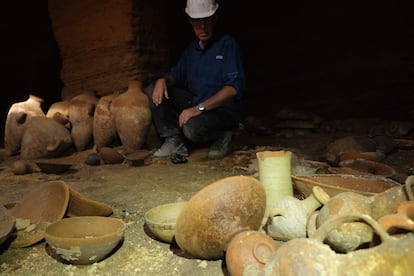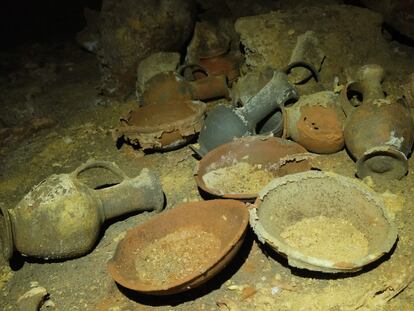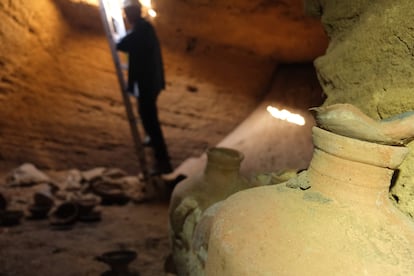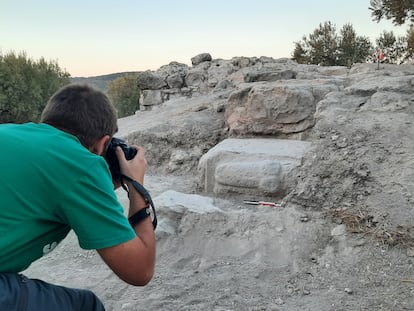‘Once in a generation’ discovery of 3,300-year-old burial cave made in Israel
The site, found by accident to the south of Tel Aviv, contains almost 100 ceramic and bronze artifacts and dates to the era of Pharoah Ramesses II

An excavator’s shovel has accidentally uncovered an Egyptian funeral cave on an Israeli beach with nearly 100 intact ceramic utensils and bronze artifacts dating to around 3,300 years ago, when the Pharaoh Ramesses II ruled over the region of the Ancient Near East then known as Canaan.
The discovery was made last Wednesday in the kibbutz of Palmachim, just south of Tel Aviv, with the artifacts apparently arranged as they had been millennia beforehand during the funeral rites, the Israel Antiquities Authority (IAA) and Israel Nature and Parks Authority said in a press release. “We knew we were in an archaeological area, but a discovery like this is only made once in a generation,” Diego Barkán, Tel Aviv district head for the Antiquities Authority, told EL PAÍS.
Among the ceramic work are bowls, some of them painted red, chalices, cooking utensils, storage jars and oil lamps. In Ancient Egypt, death was considered to be only a temporary separation of the body and the soul and not the end of a person’s life, and as such it was assumed that such objects would be of use to those being buried.
Also among the objects uncovered were bronze arrowheads and spearheads. Archeologists examining the find believe that, due to the way they were arranged, they had been placed in a quiver made of organic material that has turned to dust over the passage of time.

The excavator who made the discovery was carrying out maintenance work on the beach when she stumbled upon the entrance to the cave, which was excavated in a square shape with a central pillar. The archeologists who were dispatched to the find descended into the cave using a ladder. The artifacts will now be examined by experts to provide further knowledge of funerary customs in the late Bronze Age. “We already knew how people were buried during that era, but normally these caves were looted in ancient times. This is like entering a laboratory,” says Barkán.
The identity of the people put to rest in the cave remains unknown. Although they are extremely deteriorated, scientists will attempt to extract DNA and plants and teeth will also be analyzed for data. “As there are almost 100 receptacles, we do not know if more than one generation is buried there, which would imply several burial layers, or if they were wealthy people,” Barkán adds.
The discovery also provides further evidence of the importance of international commerce during the 66-year reign of Ramesses II, during Egypt’s Nineteenth Dynasty. The ceramics found in the cave include vessels imported from Cyprus and the ancient port city of Ugarit, in modern-day Syria, where a now extinct Semitic language, Ugaritic, was spoken. It is thought that some of the pottery also came from Ashdod and Ashkelon in Israel, the Gaza Strip and Tyre and Sidon in Lebanon, which shows that inhabitants of the region were clearly involved in intense commercial activity across the Mediterranean coasts, according to Dr. Eli Yannai, an IAA expert on the Bronze Age quoted in the press release.

Ramesses II expanded Egyptian dominion to the east, extending as far as modern-day Syria, and to the south toward Sudan. The Palmachim beach, where the discovery was made, is situated on the Mediterranean coast, between Jaffa to the north and Ashkelon to the south, fiefdoms of powerful merchants during the era the finds in the cave date to. One theory as to the identity of the people buried in the cave is that they lived in some form of pirate port, of which no trace remains today, where traders attempted to sidestep the commercial taxes levied in Jaffa and Ashkelon.
There is also evidence – which the Israeli police are investigating – that someone may have removed artefacts from the cave shortly after it was discovered and before it was sealed off by the authorities. Barkán, though, calculates that around 95% of the discoveries remain in place.
Tu suscripción se está usando en otro dispositivo
¿Quieres añadir otro usuario a tu suscripción?
Si continúas leyendo en este dispositivo, no se podrá leer en el otro.
FlechaTu suscripción se está usando en otro dispositivo y solo puedes acceder a EL PAÍS desde un dispositivo a la vez.
Si quieres compartir tu cuenta, cambia tu suscripción a la modalidad Premium, así podrás añadir otro usuario. Cada uno accederá con su propia cuenta de email, lo que os permitirá personalizar vuestra experiencia en EL PAÍS.
¿Tienes una suscripción de empresa? Accede aquí para contratar más cuentas.
En el caso de no saber quién está usando tu cuenta, te recomendamos cambiar tu contraseña aquí.
Si decides continuar compartiendo tu cuenta, este mensaje se mostrará en tu dispositivo y en el de la otra persona que está usando tu cuenta de forma indefinida, afectando a tu experiencia de lectura. Puedes consultar aquí los términos y condiciones de la suscripción digital.
More information
Últimas noticias
Most viewed
- Oona Chaplin: ‘I told James Cameron that I was living in a treehouse and starting a permaculture project with a friend’
- Sinaloa Cartel war is taking its toll on Los Chapitos
- Reinhard Genzel, Nobel laureate in physics: ‘One-minute videos will never give you the truth’
- Why the price of coffee has skyrocketed: from Brazilian plantations to specialty coffee houses
- Silver prices are going crazy: This is what’s fueling the rally











































